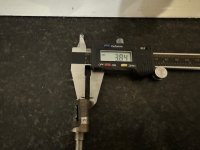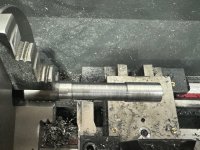WB projects
Active member
Of course minimize the shaft length is your best bet! It’s now up to you how far you want to push the project!
Interesting. Thank you for the thinking and options. I am a novice machinist! I am only just getting my head around dimensions, much less concentricity, cylindrical, and how to measure and achieve them. I only recently bought blue and red loctite. I did not even know that there was a green!I have a completly different opinion than matnrach. I do believe the flat spot a problem for the heat shrink. Try a test with a shaft with no flat like you said and I think it will be fine. I had the exact same issues when shrink fit on the shaft.
I do think drill and ream is not the solution for concentric hole. Yes you have a precise hole but I believe it’s not the solution for concentric hole. Yes you can slowly increase drill and get a better chance but I don’t beleive to be the best solution.
If you want to make an other test to see what is the best solution, I do believe you should try what I did on mine. Do you remember the procedure I did? Try a smaller fit and glue the shaft instead of shrink fit! Green locktite!
That is NOT the point I mentioned at all. The olny issue in the shrink fit is the flat on the shaft. My first motor was a TP with no flat and the shrink did work fine!If precise shrink fits do not work and create concentricity or other issues then we would not be able to fly anywhere in planes, drive around in cars or do be able to do nearly anything else that involves rotating machinery.
when is done properly, theres no half of the shaft missingOf course it works perfectly well if done properly.

This can help you to get parallel turning and not be tapered but it’s a waste of time to try to be perfect because every time you tight the tailstock, it will be different every time.
- Ensure lathe tailstock is aligned to spindle
I would suggest you to use an Endmill for concentricity. Use a 3/16 drill and 1/4 endmill
- Drill 20 mm deep hole using progressive drills: 3/16", 7/32", 1/4", 7.75 mm
You can try to machine a nice precision shaft to mount your compressor shaft on, instead of a point. Make it to be able to remove it after all your machinning. But remember, as soon you remove your shaft from the chuck, it will be useless after.
- Insert live center to support shaft big end when shaping
Thank you for the input and wisdom WB. I just tried this and it was very slick. I took some 10 mm aluminum stock and turned it down to pop-fit my extension shaft. I just tested the new shaft that I made using the procedure above and it was very clear to see the run-out issue that I had without shrink fitting it to the motor shaft and having to cut it off. I am so happy to have a tool that can help me see what is going on.You can try to machine a nice precision shaft to mount your compressor shaft on, instead of a point. Make it to be able to remove it after all your machinning. But remember, as soon you remove your shaft from the chuck, it will be useless after.
I will try your idea of the 1/4" end mill for concentricity. So, do you just mount the end-mill in the lathe tailstock in a Jacob's chuck or maybe a special collect? and it cuts on the side vs bottom edge and is stiffer that a drill bit?I would suggest you to use an Endmill for concentricity. Use a 3/16 drill and 1/4 endmill
what do you mean? you try to machined it and it turn itself on the shaft? not sure to understandI just tried this and it was very slick.
you can adjust left to right but usually not up and down. Its one of the reason I don't recommend the tail stock for concentricity. ONLY if you use something more rigid like an endmillnot properly leveled or tailstock issue.
just put it in the chuck like a normal drill! nothing special! you will instantly see if your tail stock suck or not. the endmill is super stiff so even if the tail stock is not leveled or aligned, it will cut straight no matter what. And if its the case. your hole will just be bigger. for example, if your tail is 0.002'' off and you drilled with your 1/4'' endmill, the hole will be 0.254''. instead of a drill of the same diameter, it will never see the 0.002'' of miss aligned.So, do you just mount the end-mill in the lathe tailstock in a Jacob's chuck or maybe a special collect? and it cuts on the side vs bottom edge and is stiffer that a drill bit?
Thanks WB. I just ordered more steel bar stock and plan to make more iterations of the shaft until I have one that is viable, so this is a helpful option to try.If you are not tired of making new shaft, you can try my technic hahaha!
make all the shaft in a single set-up and keep the hole for the last.
for your second set-up, instead of just flip it in the chuck, make your own ''collet'' in the chuck to grab your part. since is not the most rigid thing is the world, ruff your part first and use the collet to make the finish. again use an endmill or a boring bar to make to hole concentric the the ''collet'' you made and since you are more familiar with the reamer, its ok at this point to use it. I personally bore my hole but there's no big difference at this point since the reamer will flex and follow your concentric hole even if the tail stock is not precise.

